Cite this document
(“The Impact of Global Warming on Agriculture in USA Research Paper”, n.d.)
The Impact of Global Warming on Agriculture in USA Research Paper. Retrieved from https://studentshare.org/social-science/1651324-the-impact-of-global-warming-on-agriculture-in-usa
The Impact of Global Warming on Agriculture in USA Research Paper. Retrieved from https://studentshare.org/social-science/1651324-the-impact-of-global-warming-on-agriculture-in-usa
(The Impact of Global Warming on Agriculture in USA Research Paper)
The Impact of Global Warming on Agriculture in USA Research Paper. https://studentshare.org/social-science/1651324-the-impact-of-global-warming-on-agriculture-in-usa.
The Impact of Global Warming on Agriculture in USA Research Paper. https://studentshare.org/social-science/1651324-the-impact-of-global-warming-on-agriculture-in-usa.
“The Impact of Global Warming on Agriculture in USA Research Paper”, n.d. https://studentshare.org/social-science/1651324-the-impact-of-global-warming-on-agriculture-in-usa.


